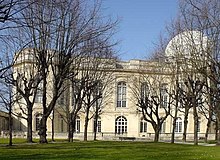Claude Perrault
Claude Perrault (Paris, September 25, 1613 - ibid., October 9, 1688) was a famous French architect, physicist, mechanic, physician and naturalist, member of the Academy of Sciences. He was the brother of the writer Charles Perrault, author of such famous tales as Little Red Riding Hood , Cinderella or Sleeping Beauty .
Work

Jean Mariette, engraving of theArchitecture françoise ou recueil des maisons royalles, de quelques églises de Paris et de châteaux et maisons de plaisance de France bâties nouvellement (1783)..
Architectural work
His most notable architectural works are: Louvre colonnade; chapel of Our Lady of Navona, in the church of the Minims; translation of Vitruvio's ten books on architecture into French; arrangement of the five kinds of columns, according to the method of the ancients. Between 1673 and 1677 he built the castle of Sceaux for Colbert. The Paris Observatory is also his work. He likewise translates from “De architectura libri decem” into French. Les dix livres d¨architecture de Vitruve, corrigez et traduits nouvellement en Français, in 1673 (The Ten Books of Architecture of Vitruvius, corrected and translated again into French.)
Sceaux Castle and Sceaux Park are located in Sceaux, in the department of Hauts-de-Seine (France). Claude Perrault, Le Brun, Le Nôtre... the architects of this splendid mansion and its park, owned by Colbert, Louis XIV's famous finance manager, compete among themselves for their prestige. The castle, destroyed and later rebuilt in the XIX century, is today the Museum of Ile-de-France, a veritable mine of information about the domaine, the ceramics, the royal residences that have disappeared and about the landscapes of the region since the XVII.
The creation of the Royal Academy of Architecture in 1671 had as its main objective the elaboration of a global doctrine of architecture that would explain the emergence of French architecture under Louis XIV (reigned 1643-1715) and, above all, preserve the general line and its tradition. The doctrinal debate revolved around Vitruvio's text, The Ten Books of Architecture, the only treatise on architecture from Antiquity that would last until that date but which had to be analyzed in more depth due to the obscure and enigmatic points still unresolved. Claude Perrault is commissioned for a new translation of Vitruvio's text, and a rigorous commentary on it "which reaffirmed his intellectual prestige" from about 1666. But the result does not correspond at all with what was expected by the Academy.
“His radical theories that heralded the birth of French rationalism and formed part of the framework of ideas of the European Enlightenment”.
Scientific work
As for his scientific works, the following stand out: Physics Essay and The Mechanics of Animals. Perrault's naturalistic work fits into the Cartesian philosophy, widespread at the time, according to which animals could be considered as machines and their organs as the pieces whose gear explained vital functions. However, Perrault was a convinced Christian, and he refused to accept that such machinery could be set in motion in the absence of a soul to give it movement.
- The "Perrault" abbreviation is used to indicate Claude Perrault as an authority in the scientific description and classification of vegetables.
Contenido relacionado
2nd century
Electroweak Spontaneous Symmetry Breaking
History of africa
